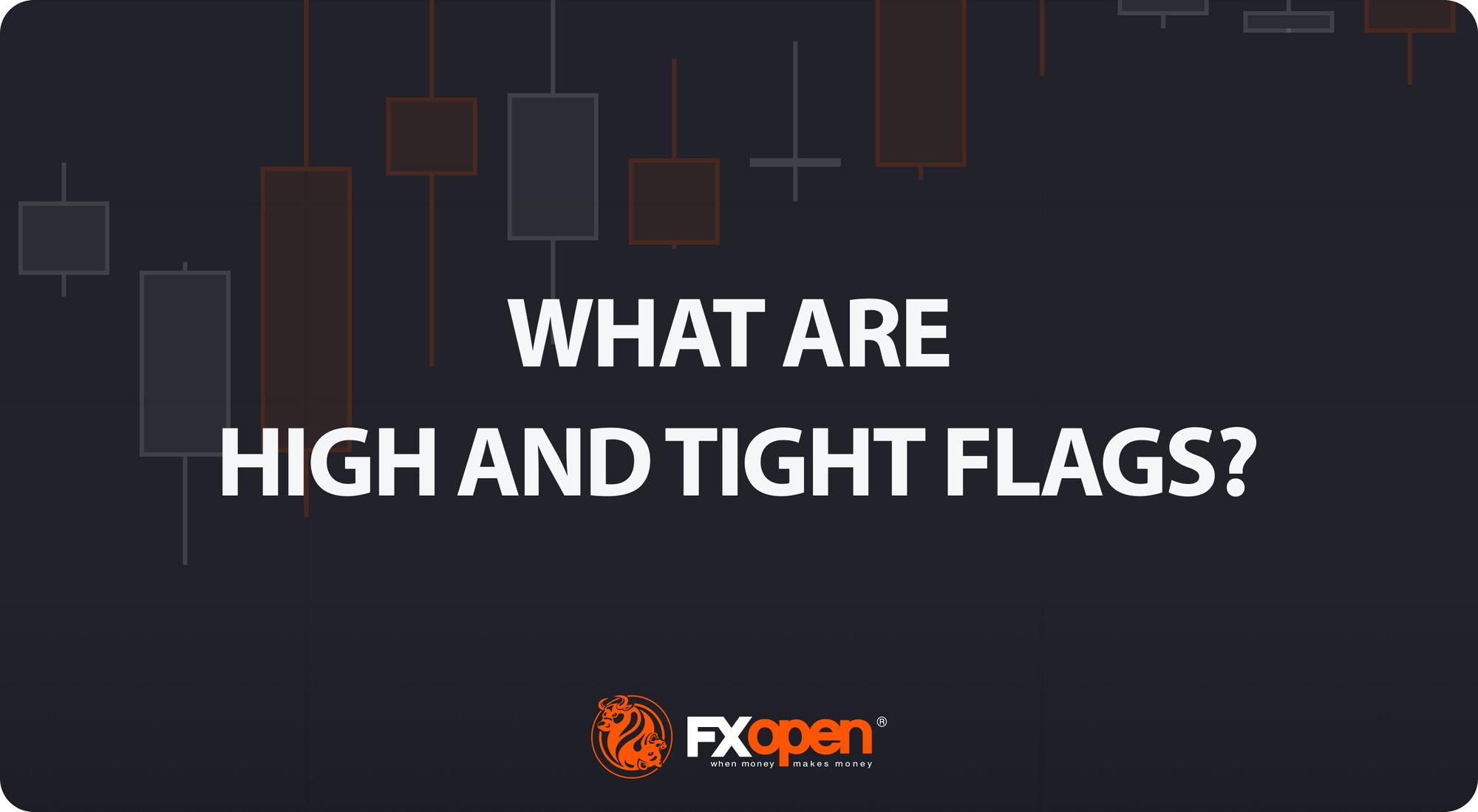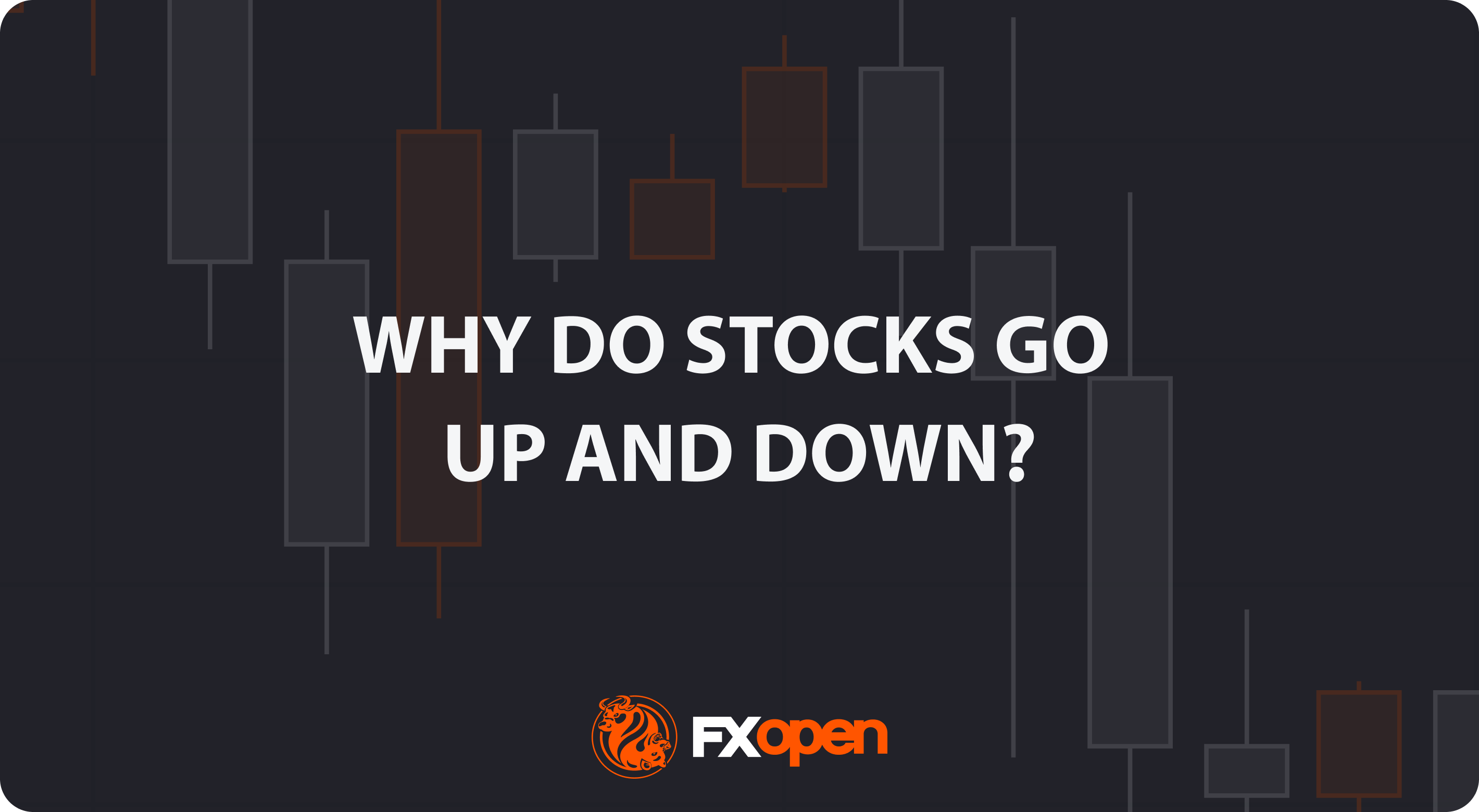FXOpen

The high and tight flag pattern is a formation in technical analysis, signalling a continuation of a strong bullish trend. Recognised by its sharp rise followed by brief consolidation, this formation is highly valued by traders. In this article, we delve into the specifics of the high and tight flag pattern, its characteristics, and how to trade it effectively.
Understanding the High and Tight Flag Pattern
You have heard of the flag pattern. The high and tight flag pattern is its version.
The high and tight flag pattern is a powerful and rare chart formation used in technical analysis. It signals a potential continuation of a strong upward trend and is favoured by traders for its reliability in bullish markets.
This formation is characterised by two main components: the flagpole and the flag. The flagpole is formed by a steep price increase, typically ranging from 50% to 100% over a short period, often spanning one to three weeks, though potentially more or less. This sharp rise indicates strong buying interest and momentum.
Following the flagpole, the flag appears as a brief consolidation period where the price moves sideways or slightly downward. This phase also usually lasts one to three weeks and represents a pause in the upward trend as traders take profits and the market digests the sharp rise. The flag portion should retrace less than 20% of the flagpole's height to maintain the pattern's integrity.
The high and tight flag is highly valued for its effectiveness. When the price breaks out above the upper boundary of the flag with increased volume, it often signals the resumption of the bullish trend. Traders view this breakout as an opportunity to enter or add to positions, anticipating further upward movement.
Characteristics of the High and Tight Flag Pattern
Here are the specific criteria that define the high and tight bull flag.
- Steep Flagpole Formation: The formation begins with a sharp price increase. This rise is typically between 50% and 100%, which is commonly observed in stock and crypto* markets. For forex or commodities, traders can simply look for large, outsized moves that may result from significant news events.
- Flag Formation: After the flagpole, the asset enters a consolidation phase. This is how the flag is formed. This part of the pattern appears as a brief sideways or slightly downward movement, indicating a pause as the market digests the rapid price increase.
- Retracement Level: During the flag formation, the price generally retraces between 10% and 20% of the flagpole's height. This retracement doesn't need to be an absolute 10% to 20% decrease in price but rather a proportional pullback relative to the initial rise.
- Timeframes: The high and tight flag can occur across all timeframes and assets. However, it is generally more accurate on medium-term timeframes, such as the 1-hour to 4-hour charts. This makes it particularly useful for swing traders who focus on these intervals.
- Breakout Confirmation: For the pattern to be validated, the price should break out above the upper boundary of the flag with renewed momentum. This breakout often signals the continuation of the prior bullish trend.
Why Does the High and Tight Flag Pattern Form?
The high and tight flag pattern is based on a combination of strong buying interest and market consolidation. Initially, a significant catalyst, such as positive news or earnings, drives a sharp price increase, creating the flagpole. This rapid ascent attracts more buyers, amplifying the upward momentum.
Following this surge, the market enters a brief consolidation phase where traders take profits and the price stabilises, forming the flag. This pause allows the market to absorb the gains without a significant pullback and accumulate more positions.
The pattern forms as investors await further confirmation of the trend, often leading to a breakout above the flag. This breakout signifies renewed buying interest and the potential for continued upward movement.
Trading the High and Tight Flag Pattern
Now, let’s look at general trading rules applied to the pattern. To trade the high and tight flag chart pattern for yourself, head over to FXOpen’s free TickTrader platform.
Step 1: Identifying the Initial Steep Flagpole Movement
The first step in trading the high and tight flag involves spotting the initial sharp upward movement, ideally within a broader uptrend. This steep rise should be between 50% and 100% over a short period or a noticeable sharp move, indicating strong bullish momentum. Traders often draw a trendline from the low to the high of this movement to visualise the flagpole.
Step 2: Watching for the Consolidation Phase
Following the flagpole, the price typically starts consolidating. This phase can appear as a weak downtrend or a sideways range, usually accompanied by lower trading volume. Traders can draw trendlines to mark the upper and lower boundaries of this consolidation, forming the flag portion.
Step 3: Waiting for a Breakout
The next crucial step is to wait for a breakout above the upper boundary of the flag. This breakout can occur at the flagpole's high or above the upper trendline drawn during the consolidation phase.
To confirm the breakout, traders often use technical indicators such as a moving average crossover or the Relative Strength Index (RSI) moving above 50, indicating bullish territory. A tightening and widening of Bollinger Bands can also indicate a breakout is underway. It’s also best to wait for a close outside of the upper boundary to prevent trading a false breakout.
Step 4: Entering the Trade, Setting a Stop, and Taking Profits
Once confirmation of the breakout is found, traders enter a trade as the price breaks out or at a retest of the trendline. Setting a stop-loss order below the low of the consolidation phase is a common risk management strategy. This helps to potentially limit losses if the formation fails to hold. Profits might be taken at a 1.5x extension of the flagpole, i.e. taking half of the flagpole’s size and adding it to the flagpole’s high.
Advantages and Disadvantages of the High and Tight Flag Pattern
The high and tight flag is a popular tool among traders for its reliability and clear signals, but it comes with both benefits and challenges.
Advantages
- High Reliability: When identified correctly, this pattern often indicates strong bullish continuation, providing clear entry points.
- Strong Momentum: The pattern reflects significant buying interest, suggesting sustained price movement.
- Easy Identification: The sharp rise followed by a brief consolidation makes it visually distinct and easier to spot.
Disadvantages
- Rarity: This pattern is relatively rare, limiting trading opportunities.
- False Breakouts: Without proper confirmation, breakouts can fail, leading to potential losses.
- Market Dependency: Best observed in stocks and cryptocurrencies*, it may be less effective in forex or commodities.
- Risk of Over-Reliance: Solely relying on this pattern without additional analysis or indicators can increase trading risk.
The Bottom Line
The high and tight flag is a powerful tool for identifying strong bullish trends. By understanding its characteristics and applying effective trading strategies, traders can potentially enhance their market performance. To put these strategies into practice and take advantage of market opportunities, consider opening an FXOpen account. FXOpen offers a robust platform for trading and a wide range of assets to help you execute your trading plans with confidence.
FAQs
What Is a High and Tight Flag Pattern?
A high and tight flag pattern is a chart formation in technical analysis that signals a continuation of a strong upward trend. It consists of a steep rise in price (the flagpole) followed by a short period of consolidation (the flag). It is typically seen in stocks and cryptocurrencies* and indicates strong buying momentum, though it can be applied to forex and commodities.
How to Identify a High and Tight Flag?
Identifying a high and tight flag involves looking for an initial sharp price increase of 50% to 100% over a short period, forming the flagpole. This is followed by a brief consolidation phase, where the price moves sideways or slightly downward, usually a retracement of 10% to 20%, creating the flag. Drawing trendlines along the high and low points of these phases helps visualise the pattern.
What Is the Buy Point for a High and Tight Flag?
According to the theory, the buy point for a high and tight flag occurs when the price breaks out above the upper boundary of the flag. Traders often look for confirmation of the breakout using indicators such as a moving average crossover or RSI moving into bullish territory. By entering a trade at this point, traders can potentially take advantage of the continued upward momentum.
*At FXOpen UK and FXOpen AU, Cryptocurrency CFDs are only available for trading by those clients categorised as Professional clients under FCA Rules and Professional clients under ASIC Rules, respectively. They are not available for trading by Retail clients.
This article represents the opinion of the Companies operating under the FXOpen brand only. It is not to be construed as an offer, solicitation, or recommendation with respect to products and services provided by the Companies operating under the FXOpen brand, nor is it to be considered financial advice.
Stay ahead of the market!
Subscribe now to our mailing list and receive the latest market news and insights delivered directly to your inbox.








